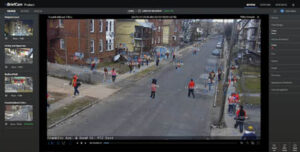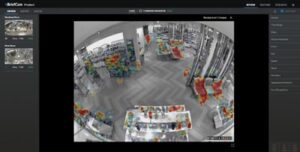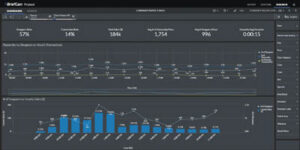Video is a great enabling resource and provides a range of benefits to many businesses and organisations. It can deliver security protection, safety and compliance when used as a surveillance tool; however, the performance of solutions can be elevated where a smart video analytics platform is deployed. These bespoke systems, such as the BriefCam Video Content Analytics Platform, have been designed to exploit the available video data and add business and management benefits. Here Benchmark takes a closer look at BriefCam’s platform to see what it offers.
It could be argued that video surveillance is a victim of its own success. Many years ago, the role of video surveillance was simple. A user would place several cameras around their site, and the feeds would be watched by operators, or the footage would be recorded, or in the case of high-risk sites, both approaches would be used. If an incident occurred, the operator would react to an alarm or the footage would be viewed after the incident had been detected.
Not only were systems simpler, but they were also smaller. This was partly due to the cost of physical hardware, and partly due to the limitations of the technology deployed.
In recent years, the approach to designing video solutions has changed. Today’s systems are larger and more complex. Network infrastructure removes many of the limitations of previous systems, devices are more cost-effective, and resolutions have increased. As systems have become smarter, end users are more willing to invest in technology as they can realise a return on investment. The addition of business efficiencies has also accelerated this.
The result of these developments is that today’s surveillance systems are capturing more data than ever before, and that data has a value to the user, even if alarm incidents do not occur. The downside is that the sheer volume of data being captured and archived makes finding the right information in a timely fashion a challenge.
However, by deploying a smart video analytics platform, it becomes simpler, faster and less labour intensive to find and use appropriate video information. One such vehicle to achieve this is the BriefCam Video Content Analytics Platform.
THE BENEFITS AVAILABLE FROM INTELLIGENT ANALYTICS PLATFORMS
A flexible platform
BriefCam is an intelligent and comprehensive video analytics platform which delivers innovative analytic capabilities, allowing end users to quickly and effectively search, analyse and act on intelligence gained from real-time, or on-demand video content. Through AI, Deep Learning, advanced object detection, identification and classification, it allows operators to make sense of the video data they hold by implementing advanced processing to filter objects to pinpoint and track targets, understand timelines and trends of activity and provide real-time alerting, as well as dashboards for visualising and analysing data.
BriefCam’s REVIEW, RESPOND and RESEARCH solutions enable the comprehensive platform approach to video content analytics. REVIEW is used for post event investigation based on recorded footage and allows advanced searching and filtering based on the extracted and aggregated video metadata, and the creation of cases to organise the video assets of an investigation, which can be used for evidential purposes. RESPOND uses advanced filtering and rules to generate alerts based upon activities, objects or scenarios detected in live video streams. RESEARCH is a powerful reporting and dashboarding tool which enables users to visualise, assess and compare aggregated video data to detect trends, plan business strategies, assess performance and define security and operational procedures.
REVIEW
The REVIEW component of BriefCam is where you work with recorded footage. The layout of the GUI is logical and makes searching, filtering and viewing footage a simple and intuitive task. On the left of the screen there are thumbnails of the various video streams, with additional data such as camera name and, if a filter has been applied, a count of how many specified objects have been found. On the right-hand side are filters which can be applied to video streams, either individually or across multiple videos, to find relevant data.
 The central part of the screen changes dependent upon which tasks are being carried out. For example, it could include a video stream playing in real-time, a BriefCam VIDEO SYNOPSIS view or thumbnails of filtered incidents and occurrences. The layout allows for simple navigation of the system and the manipulation of video in different ways. This ensures the fastest route to the relevant video clips for the operator.
The central part of the screen changes dependent upon which tasks are being carried out. For example, it could include a video stream playing in real-time, a BriefCam VIDEO SYNOPSIS view or thumbnails of filtered incidents and occurrences. The layout allows for simple navigation of the system and the manipulation of video in different ways. This ensures the fastest route to the relevant video clips for the operator.
When investigating incidents, the VIDEO SYNOPSIS capability offers a logical start-point, as this allows a short video clip to display hours’ worth of activity in seconds. Without any filtering, the VIDEO SYNOPSIS will show all objects in captured footage, and each identified object will be marked with a time stamp (date information can be included if the search spans multiple days). The density of the VIDEO SYNOPSIS can be adjusted, but as the time of the video clip is shortened, more objects appear simultaneously.
In a typical street scene, the detected objects might include people, vehicles, animals, etc.. This can be distracting and overload the operator who is looking for a suspicious incident to start the search. However, there are additional search attributes and behaviours available to further target the search, which is where the intelligence can quickly turn a labour-intensive task into an efficient one.
The operator can either use filtering or create a region of inclusion or exclusion within the scene and look for activity within that area only. The two can be combined, allowing filtering within a region of interest. With a single mouse-click, the object classification being searched for can be set: people, two wheeled vehicles or other vehicles being the most common options. By selecting ‘people’, for example, only humans in the scene (or region of interest, if applied) will be shown. This filtering can be applied to a single region, a full camera scene, or multiple cameras.
When an object of interest is seen, the operator only needs to click on the relevant time/date stamp and they instantly call up the full video clip of that scene. As well as searching via the VIDEO SYNOPSIS, it is possible to add visual layers which provide additional information.
 For example, a scene can be viewed with an activity overlay. This creates a heat map showing where the greatest levels of activity are during the selected search period. This proved invaluable in a law enforcement case when a suspected drug dealer’s premises was identified by abnormal levels of activity to and from his residence.
For example, a scene can be viewed with an activity overlay. This creates a heat map showing where the greatest levels of activity are during the selected search period. This proved invaluable in a law enforcement case when a suspected drug dealer’s premises was identified by abnormal levels of activity to and from his residence.
Alternatively, dwell times can be overlaid to identify places where people (or other filtered objects) loiter. The time windows are user adjustable. Paths can also be set, which only identify targets which travel through an area in a specified direction.
The use of overlays allows the operator to immediately understand trends in the video without spending hours analysing the real-time footage. The information can be used for a variety of purposes ranging from security and law enforcement through to business intelligence tasks and site management, monitoring traffic flow, customer densities, traffic and parking violations, etc.
Using the various filters can help to drill down into the captured data to carry out specific and accurate searches. When the filters are used, the central screen shows a selection of thumbnail images which match the filtering criteria. Thumbnails can be sorted by relevance to the filters applied, or by oldest or newest footage.
The filters can be split into classifications: people, two wheeled vehicles, vehicles, light (on/off) and animals. These are then further broken down into subsections, allowing a higher degree of filtering to be implemented.
People can be specified as male, female or children. Two wheeled vehicles can be broken down to bicycles and motorcycles. Subgroups for vehicles include cars, vans, pick-up trucks, lorries, buses, trains, airplanes and boats.
Once the class is selected, further filters can be applied to refine the results. Person attributes allow clothing colours to be selected for upper and lower body, as well as details such as whether they are wearing a hat, carrying a bag, etc..
The clothing or vehicle colour of targets can also be selected, and there is the ability to tweak the sensitivity to allow for changes in shade, intensity and coverage. This allows a fast way of adapting searches, ensuring all relevant targets are identified.
It is also possible to filter results based upon object size, shape, dwell time and direction of travel. This ensures that finding specific events can be done with a high degree of accuracy, ensuring relevant footage is available during investigations.
There are two final filters which can add value when an incident is being investigated. The first is Appearance Similarity. This allows a target such as a vehicle or person to be identified, and the system will then apply to filter to identify similar targets in the footage. The range of similarities can be defined, and might be visual similarities, or vehicles travelling in the same direction at a similar speed. This is a very powerful tool when used in conjunction with a range of filters.
Finally, a facial recognition filter can be applied. Operators can compare faces detected in video against a database or watchlist of digital images – either extracted from video or from external sources – of persons of interest. Video can be searched for all instances of a face in a camera scene or region of interest. The results will be shown as thumbnails, and each will have a star rating applied. One star denotes the presence of a face, but with two or three stars, the face data can be used to identify other instances of the same person. Additionally, the BriefCam RESPOND module enables the triggering of real-time alerts to notify security staff when a face in a video matches one on the watchlist, so that qualified personnel can assess the match and determine how to respond.
RESPOND
The RESPOND module of BriefCam uses object filters and user-configurable rules to generate real-time alerts when violations or exceptions are detected. These can be used to notify operators of events, so that they can quickly assess and determine how to respond. For example, if a directional path is established in a region of interest, any person (or other selected object class) passing through the selected area in the defined direction would create an alarm or notification.
 There is a choice regarding how the alerts are delivered. Real-time alerts are simpler detection events and are typically signalled within 5 seconds of an event, allowing a virtually immediate response from the operator. Where more complex needs must be met, a smart alert can be generated. This uses a wider range of criteria but does result in the alert taking slightly longer to be generated as the analysis is more complex.
There is a choice regarding how the alerts are delivered. Real-time alerts are simpler detection events and are typically signalled within 5 seconds of an event, allowing a virtually immediate response from the operator. Where more complex needs must be met, a smart alert can be generated. This uses a wider range of criteria but does result in the alert taking slightly longer to be generated as the analysis is more complex.
Defining rules is simple and can be done without any need for advanced programming or writing macros. The menus are intuitive and allow a high degree of flexibility. These can make use of multiple defined regions of interest and filters to ensure flexible and accurate results.
RESEARCH
The RESEARCH module allows the creation of reports and statistics. These can be used to view and interrogate event logs, alarms, events and incidents, as well as applying data for trend analysis.
 For example, dashboards can be created to view data, both current and historical, which gives business insights as well as security information. In a retail environment, the user could view figures for customer numbers, shopper profiles such as shopper gender demographics, visit durations and zones within the premises which experience the highest footfall. Comparisons can be added with previous weeks, months or years.
For example, dashboards can be created to view data, both current and historical, which gives business insights as well as security information. In a retail environment, the user could view figures for customer numbers, shopper profiles such as shopper gender demographics, visit durations and zones within the premises which experience the highest footfall. Comparisons can be added with previous weeks, months or years.
Displays in RESEARCH are user-friendly and allow at-a-glance assessments as they can include graphs, charts, diagrams, heat maps, etc. Displays can be manipulated using classifications and filters, thus allowing the stored data to be mined for valuable insights.
In terms of security, the RESEARCH module can be used to create in-depth reports which will be useful for trend identification, personnel management, compliance, and overall business intelligence.
In summary
Applying a smart analytics platform can elevate the value of any surveillance system by ensuring the technology delivers critical insights and valuable information to ensure higher levels of efficiency. As demand for smart solutions increases, so integrators and consultants who offer a higher level of interoperability will see increased sales as users come to expect more from their solutions.
Today’s video surveillance systems offer so much more than surveillance, and the inherent value of the captured data can be realised via a smart analytics platform. BriefCam leverages the full power of the system, delivering a superior return on investment for the customer, and that has to be a good thing for all stakeholders.
THE BENEFITS OF SMART VIDEO ANALYTICS PLATFORMS TO END USERS








